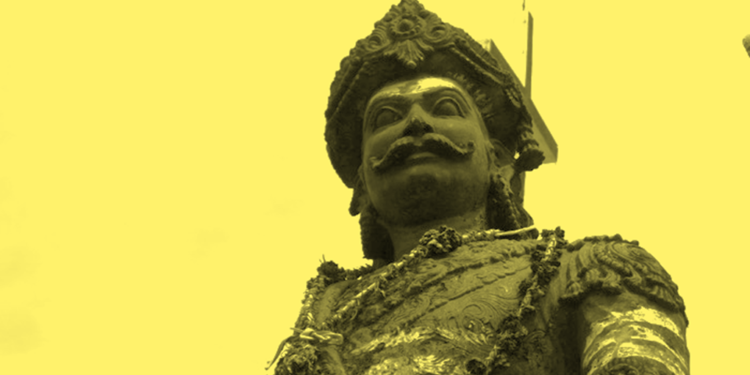Our motherland is called “Veer Bhoomi” as so many valiant heroes fought for her and laid down their lives in great honour, while fighting the foreign invaders. Pandiya naadu in south Tamilnadu stretching from Madurai to Tirunelveli is quite famous in this regard especially for the Polygar wars and is indeed a “Veeram vilaindha nilam” (a land where courage is cultivated).Veerapandiya Kattabomman Karuthayya Nayakkar, the 47th ruler from the Kattabomman clan near Tuticorin, was one of the Polygars (Palayakkarars) – the subordinates of the erstwhile Naicker rulers of Madurai who appointed them as regional chieftains of their different divisions (Palayams) to administer, collect taxes, and also maintain a battalion of troops. It is said that during a hunting trip into the forests of Salikulam, one of the Kattabommans saw a hare chasing a hound, so he built a fort there and named it Panchalankurichi, as he believed the land there has the power to instil courage.
After the Madurai kingdom came under Nawab of Arcot, from the Naickers, during the eighteenth century, the Polygars refused to recognize the new Muslim rulers. As the Nawab was indulging in building big palaces for himself, he became bankrupt as he was not able to collect monies from the Polygars. The Nawab then had to borrow huge sums from English East India Company and in lieu of that he gave the right to collect the taxes from the Southern region to the British, which in turn helped them to plunder the wealth of the whole region.
Many of the Polygars surrendered to them with the exception of Veerapandiya Kattabomman and a few others with whom he had formed an alliance. Despite many attempts by the Company, he refused to meet Jackson Durai, the Collector of East India Company for a long time. Finally when he met him in Ramanathapuram, the meeting turned violent and a British Deputy commandant named Clark was killed in the skirmish. Kattabomman and his men valiantly fought their way out from there, though his secretary Thanapathi Pillai was taken as a prisoner by East India Company. Later, the Commission of Enquiry fixed the blame on Jackson and removed him from his post, as they feared that the fight with Kattabomman would make other Polygars to also revolt and mar their plans to take over the whole region.
The new Collector of Tirunelveli, Louingston, then wrote to Veerapandiya Kattabomman calling him for another meeting. Kattabomman wrote back citing extreme drought conditions for the delay in payment and also demanded that all that was robbed off him at Ramanathapuram be given back. The continued refusal by Kattabomman to meet the Collector or to pay taxes, forced him to recommend a military attack against Kattabomman. The Collector also instigated Kattabomman’s feuding neighbor, the Polygar of Ettayapuram, to attack him for their long pending territorial disputes, thus executing the “divide and rule” policy.
Under Major Bannerman, the army stood at all the four entrances of Panchalankurichi fort. Veerapandiya Kattabomman and his forces audaciously fought them and slew their Commander Lt. Collins at the Southern entrance. The British suffered huge losses, and ordered for reinforcements, especially cannons. Sensing that his fort could not withstand the barrage from cannons, Kattabomman left the fort that night. The British then set a price on Kattabomman’s head and they executed Thanapathi Pillai and 16 others. Pillai’s head, perched on a bamboo pole, was put on display at Panchalankurichi to demoralize the fighters.
Veerapandiya Kattabomman was on the run and took refuge in the forests close to Pudukkottai and was planning to regroup himself with others to attack the British again. Through many leads given by traitors, the British found his location and ordered their stooge, the Raja of Pudukottai to arrest him. He was then captured and after a trial of three weeks, was sentenced to death for treason, but offered him to seek pardon to set him free. The brave Kattabomman refused and said “Do what you want you cowards.” He was then hanged unceremoniously on a tamarind tree in Kayathar (near Tirunelveli) on October 16, 1799. They could never defeat him in a direct fight, but he was done in by the traitors through their deceit.
The fort of Panchalankurichi was razed to the ground and all the wealth was looted by the British. They were so much scared of that land and the courage that soil could generate for its sons, that a few years later, the site of the fort was ploughed up and sowed with castor oil and salt so that it should never again be inhabited.
In his Tinnevelly Gazetteer of 1917, H. R. Pate notes the presence, in Kayathar, of “a great pile of stones of all sizes, which represents the accumulated offerings by wayfarers of the past hundred years. Folk songs recalling the heroism of the Polygar leaders remain alive in Tamilnadu to this day…”
Trivia : India’s premier communication nerve centre of Indian Navy near Tirunelveli is named after Veerapandiya Kattabomman in his honour as INS Kattabomman































